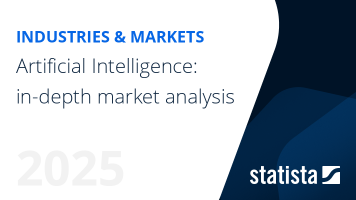Natural Language Processing - United Kingdom
United Kingdom- The market size in the Natural Language Processing market is projected to reach US$3.53bn in 2025.
- The market size is expected to show an annual growth rate (CAGR 2025-2031) of 42.33%, resulting in a market volume of US$29.34bn by 2031.
- In global comparison, the largest market size will be United States (US$11.30bn in 2025).
Definition:
Natural language processing (NLP) is a branch of artificial intelligence that focuses on the interaction between human language and computers. Natural language processing tools analyze, understand, and generate written, oral, and visual formats of human language. The Natural Language Processing (NLP) market has relevance for the healthcare, finance, and e-commerce industries in the areas of sentiment analysis, chatbots, and language translation.
Structure:
The Natural Language Processing (NLP) market has three markets. The Text-Based NLP market covers applications that analyze written forms of language. The Speech-Based NLP market covers applications that interpret and understand spoken language. The Language Translation NLP market covers applications that convey the content and meaning of a text from one language into another language.
Additional Information:
The market comprises two key performance indicators: market sizes, and market sizes by industry. Market sizes are generated by the funding amount of Computer Vision companies. Key players of the market include companies such as Amazon Web Services (AWS), Microsoft Azure Cognitive Services, and Google.
For more information on the data displayed, use the info button right next to the boxes.
- Natural language processing tools such as chatbots, virtual assistants, and sentiment analysis that enable machines to understand, interpret, and generate human languages.
- Non-artificial intelligence applications such as spell checking and grammar correction, which do not involve semantic analysis or machine learning.
Market Size
Notes: Data was converted from local currencies using average exchange rates of the respective year.
Most recent update: Oct 2025
Source: Statista Market Insights
Notes: Data was converted from local currencies using average exchange rates of the respective year.
Most recent update: Oct 2025
Source: Statista Market Insights
Analyst Opinion
Current trends in natural language processing (NLP) include the increasing adoption of NLP solutions in the healthcare, finance, and customer service industries, among others. There has also been a shift towards using deep learning techniques for NLP tasks, which has led to improved accuracy and efficiency. Another trend is the development of multilingual NLP models that can understand and process multiple languages.
Growth factors in this market include the rising demand for advanced chatbots and virtual assistants as well as the need for sentiment analysis and opinion mining in social media and other platforms. The increasing use of NLP for predictive analytics and data-driven decision-making is also expected to drive market growth. Additionally, the growing popularity of voice assistants and speech recognition technologies is expected to boost the NLP market.
The Natural Language Processing (NLP) market is expected to continue growing significantly in the coming years, with a forecasted CAGR of over 15.1% from 2023 to 2030. This growth is attributed to the increasing demand for NLP solutions across various industries and applications, including healthcare, finance, e-commerce, and customer service. The development of new and advanced NLP models as well as the increasing use of artificial intelligence and machine learning technologies is also expected to fuel market growth. Additionally, the growing trend of virtual assistants and chatbots is expected to drive the adoption of NLP solutions in the coming years.
Global Comparison
Notes: Data was converted from local currencies using average exchange rates of the respective year.
Most recent update: Oct 2025
Source: Statista Market Insights
Methodology
Data coverage: The data encompasses B2B, B2G, and B2C enterprises. Figures are based on the funding values from different industries for the market.
Modeling approach / Market size:Market sizes are determined through a top-down approach with a bottom-up validation, building on a specific rationale for each market. As a basis for evaluating markets, we use annual financial reports, funding data, and third-party data. In addition, we use relevant key market indicators and data from country-specific associations such as GDP, number of internet users, number of secure internet servers, and internet penetration. This data helps us estimate the market size for each country individually.
Forecasts:In our forecasts, we apply diverse forecasting techniques. The selection of forecasting techniques is based on the behavior of the relevant market. For example, the S-curve function and exponential trend smoothing are well suited to forecast digital products and services due to the non-linear growth of technology adoption. The main drivers are the level of digitalization, the number of secure internet servers, and the revenue of the Public Cloud market.
Additional Notes: The data is modeled using current exchange rates. The impact of the COVID-19 pandemic and the Russian-Ukraine war are considered at a country-specific level. The market is updated twice a year. In some cases, the market is updated on an ad-hoc basis (e.g., when new, relevant data has been released or significant changes within the market have an impact on the projected development). Data from the Statista Consumer Insights Global survey is weighted for representativeness.
Key Market Indicators
Notes: Based on data from IMF, World Bank, UN and Eurostat
Most recent update: Jan 2025
Source: Statista Market Insights
Explore more high-quality data on related topic
Artificial intelligence (AI) worldwide - statistics & facts
Explore more high-quality data on related topic
Artificial intelligence (AI) in the U.S. - statistics & facts
Contact


+44 (0)20 8189 7000
Mon - Fri, 9:30am - 5pm (GMT)

Mon - Fri, 10:00am - 6:00pm (JST)

+1 212 419-5774
Mon - Fri, 9am - 6pm (EST)

+65 6995 6959
Mon - Fri, 9am - 5pm (SGT)



